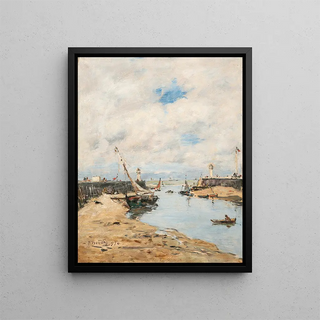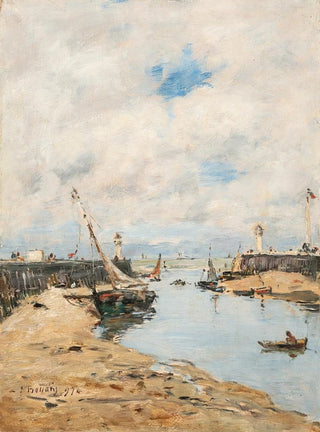Painting Trouville, the grounded schooner - Eugène Boudin | Art print


View from behind

Frame (optional)
Trouville Art print, the stranded schooner - Eugène Boudin – Captivating introduction
The sea, in all its majesty, is the central subject of Eugène Boudin's "Trouville, the stranded schooner" art print. Painted in 1869, this canvas evokes not only the beauty of the Norman coastal landscapes but also the interaction between man and nature. The artwork transports us to the shores of Trouville, where a stranded schooner seems to tell a story of maritime challenges and resilience. Light plays a crucial role in this composition, creating an atmosphere that is both melancholic and lively. By contemplating this piece, the viewer is invited to feel the sea breeze and hear the whisper of the waves, immersing themselves in a unique sensory experience.
Style and uniqueness of the work
Boudin, a pioneer of Impressionism, stands out for his innovative approach to light and color. In "Trouville, the stranded schooner," he uses a rich and nuanced palette that captures the reflections of the sky on the water, as well as the nuances of the clouds. The brushstrokes, both swift and delicate, demonstrate his skill in capturing fleeting moments. The schooner, although central in the composition, appears almost secondary compared to the vastness of the sea and sky. This visual hierarchy emphasizes man's humility in the face of nature. The scene, both realistic and poetic, invites deep contemplation, revealing the subtleties of a landscape in perpetual change.
The artist and his influence
Eugène Boudin, born in 1824 in Honfleur, is often regarded as one of the pioneers of Impressionism, long before this movement gained momentum. His passion for plein air painting allowed him to develop a distinctive style that influenced many artists, including Claude Monet. Boudin was able to capture the essence of marine and coastal landscapes, offering an authentic vision of life by the water. His works, often imbued with a certain melancholy, reveal a deep respect for nature. By choosing simple yet evocative subjects, he established a strong emotional connection with

Matte finish

View from behind

Frame (optional)
Trouville Art print, the stranded schooner - Eugène Boudin – Captivating introduction
The sea, in all its majesty, is the central subject of Eugène Boudin's "Trouville, the stranded schooner" art print. Painted in 1869, this canvas evokes not only the beauty of the Norman coastal landscapes but also the interaction between man and nature. The artwork transports us to the shores of Trouville, where a stranded schooner seems to tell a story of maritime challenges and resilience. Light plays a crucial role in this composition, creating an atmosphere that is both melancholic and lively. By contemplating this piece, the viewer is invited to feel the sea breeze and hear the whisper of the waves, immersing themselves in a unique sensory experience.
Style and uniqueness of the work
Boudin, a pioneer of Impressionism, stands out for his innovative approach to light and color. In "Trouville, the stranded schooner," he uses a rich and nuanced palette that captures the reflections of the sky on the water, as well as the nuances of the clouds. The brushstrokes, both swift and delicate, demonstrate his skill in capturing fleeting moments. The schooner, although central in the composition, appears almost secondary compared to the vastness of the sea and sky. This visual hierarchy emphasizes man's humility in the face of nature. The scene, both realistic and poetic, invites deep contemplation, revealing the subtleties of a landscape in perpetual change.
The artist and his influence
Eugène Boudin, born in 1824 in Honfleur, is often regarded as one of the pioneers of Impressionism, long before this movement gained momentum. His passion for plein air painting allowed him to develop a distinctive style that influenced many artists, including Claude Monet. Boudin was able to capture the essence of marine and coastal landscapes, offering an authentic vision of life by the water. His works, often imbued with a certain melancholy, reveal a deep respect for nature. By choosing simple yet evocative subjects, he established a strong emotional connection with
12,34 €






